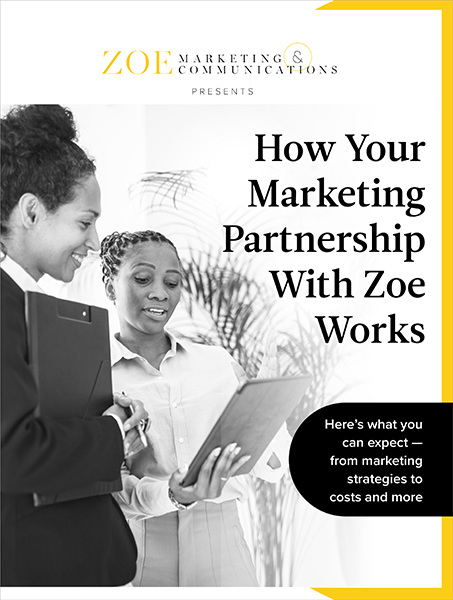
Download Your Guide to Marketing With Zoe
From the first steps and your role in success to specific services, pricing and success stories, learn all about partnering with Zoe.
Topics:

Stop me if you’ve heard this before: “So, we’ll run a geofenced PPC ad, add a pixel, retarget, and drive engagement with social ads.”
Huh? If you’re new to digital marketing, that’s quite a word salad. It was for me, too, when I first got started with marketing writing in 2022! And at Zoe Marketing & Communications, we work with plenty of marketing newcomers, so we like to keep things clear.
That’s why we created this go-to glossary — quick, simple and jargon-free.
From the first steps and your role in success to specific services, pricing and success stories, learn all about partnering with Zoe.
Running two versions of an ad, email or webpage to see which performs better. Change one element at a time for clear results.
Building recognition and trust, not pushing for immediate sales. The opposite of conversion marketing.
The three stages leading to a purchase:
The percentage of people who click a link in an email or ad. Averages:
Focused on immediate actions — think sign-ups, purchases, form fills. It’s the opposite of brand awareness marketing.
The percentage of people who take a desired action after engaging with your marketing.
What happens after the buyer’s journey ends in a sale. Keeping customers engaged through content, rewards and support boosts loyalty.
How much a customer is worth over time. Knowing this helps determine how much to spend on acquiring new customers.
A platform like WordPress or Squarespace that lets you create, edit and manage your website content without coding.
A tool (e.g., Salesforce, HubSpot) for managing customer interactions, email campaigns and data.
Direct communication via email. There are two main types:
Any action taken on your marketing — likes, clicks, shares, comments. High engagement means high interest.
Targeting ads to people within a specific physical location using their mobile data.
The number of times your ad or content is seen — whether it’s clicked or not.
Attracting customers by offering helpful content (blogs, guides, videos) rather than pushing ads at them. It has three parts:
The journey prospects take before converting:
(Different tactics work at different stages.)
The percentage of people who open your email. The average is 10%-25% and depends on industry.
The total number of times a webpage is loaded, including repeat views.
Paid ads where you’re charged per click. Google Ads is the most common example. (Also known as search engine marketing or SEM)
A small piece of code that tracks site visitors and allows for retargeting.
Automated, data-driven ad buying for better targeting and efficiency.
The total number of unique people who saw your content or ad.
Email-based marketing to people who’ve engaged with your brand.
Serving ads to people who visited your site but didn’t convert.
Optimizing your site to rank higher in search results organically (without paying).
Paying for visibility in search results via PPC ads.
Using organic posts and paid ads on social platforms to engage and convert customers.
Paid articles that position your brand as a helpful resource while subtly promoting your expertise.
Tags added to links to track where website traffic comes from in Google Analytics.
A short, clear statement explaining why customers should choose you over the competition.
Marketing is packed with terms, but now you have a solid foundation. Want to take the next step? Talk to us. Since 2020, Zoe Marketing & Communications has helped businesses turn marketing confusion into strategy.
Still figuring out what’s right for more? Read up on:

From the first steps and your role in success to specific services, pricing and success stories, learn all about partnering with Zoe.
As Zoe Marketing & Communications’ content manager, Kim Kovelle brings over 20 years of writing and editing experience in metro Detroit. She has strong roots in community journalism and a knack for making complicated topics make more sense.
Topics:
